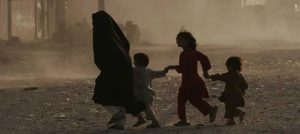Afghanistan: A Treasure Worth More than a Trillion Dollars
 6 September 2022
6 September 2022

Over one year after the Taliban takeover, an estimated 24.4 million people – 59 per cent of the population in Afghanistan – are dependent on international aid and emergency relief in their day-to-day lives. Credit: UNAMA/Fraidoon Poya
By Baher Kamal
MADRID, Sep 6 2022 (IPS)
Both mainstream media, international bodies and human rights defenders continue to rightly denounce the Taliban’s inhuman abuses against the Afghan people’s basic rights, in particular those of women and girls.
In doing so, they use a similar vocabulary, saying that since the Taliban “seized the power” on 15 August 2021 everything has collapsed. Shouldn’t it be more accurate to say that the power was “knowingly” “delivered” to them by the United States of America following negotiations between the two parties under Donald Trump’s administration?
How come the Taliban managed, in just weeks, to push Afghanistan’s economy into “free fall” as defined by the UN Emergency Relief Coordinator, already in December 2021 – that’s only four months since the power was handed to them?
Other statements talk about how the Taliban’s regime has in just a few months erased with a stroke of a pen all the “great achievements” made over 20 years of US and allies’ massive military attacks on Afghanistan’s unarmed population.
Has all this happened in just 12 months?
How come the Taliban managed in just weeks to push Afghanistan’s economy into “free fall” as defined by the UN Emergency Relief Coordinator, already in December 2021 –that’s only four months since the power was handed to them?
How come that in such a relatively short time the Taliban have hurled into hunger as many as 23 million people – around 60% of the total population?
Have they in one year pushed over 6 million Afghans away to neighbouring countries like Pakistan and Iran?
Then, how come that “Over one year after the Taliban takeover, an estimated 24.4 million people – 59 per cent of the population in Afghanistan – are dependent on international aid and emergency relief in their day-to-day lives,” as stated by the International Organization for Migration (IOM)?
“Since August 2021, nearly all Afghans have plunged into poverty and the country has been facing the risk of systemic collapse,” states IOM.
Add to this the reiterated UN disparate appeals for funding to provide “lifesaving” assistance to 21 million Afghans or 50% of the whole population.
By the way: weren’t the United States who helped, funded –and armed– the Taliban “moderate” predecessors, over the 70s and 80s, to expel the Soviet Union’s troops from Afghanistan?
Weren’t the US and allies aware that the “narco lords” in Afghanistan, the world’s largest opium producer, have also been providing money and weapons to the Taliban in exchange for protection?
Operation “Enduring Freedom”
Whatever the case is, the Afghan war narrative should also remind us of other “great achievements” made during the two-decade-long “Enduring Freedom” operation launched against this country by the then US president George W. Bush and allies.
Has this Operation Enduring Freedom really brought food, health, education, safety, democracy, stability… and freedom?
Regardless of the arguments used to “justify” them, wars are also a “good” business.
Indeed new weapons have been tested; killing-drones perfected, troops casualties lessened; fully-equipped private armies made big profits as did the giant weapons industry. And the strategic concept of “war on terror” has definitely been settled.
Another under-reported war trophy
Anyway, there seem to be other under-reported “great achievements.” One of them appears to be Afghanistan’s treasure of precious mineral resources that the technology and war business needs.
Just see this: the 2019 official report: Mining Sector Roadmap, published by Afghanistan’s Ministry of Mines and Petroleum [PDF], and introduced by the then Afghan president Mohammad Ashraf Ghani, states the following, among other facts:
– Afghanistan has “extensive” mineral resources, located in every province of the country;
– Afghanistan has world-class deposits of iron, ore, copper, gold, rare-earth minerals, and a host of other natural resources… And oil and gas;
– Other minerals include aluminium, gemstones; lead, zinc, mercury; chromite; sulphur; hydrocarbons; asbestos; marble, lapis lazuli, emeralds and rubies; …
– Afghanistan holds more than a trillion dollars worth of mineral resources;
– Afghanistan “must’‘ leverage the expertise of the “private sector“ to harness the potential of its mineral sector, the official report highlights.
This Afghan government official report was published in 2019, i.e., while the United States and allies were still ruling the country.
Too many questions left unanswered
Just take a look at what a brilliant analyst and Nobel Peace Laureate, John Scales Avery, wrote in his recent must-read article: Making Money from War.
“If the aim of the “War on Terror” had been to rid the world of the threat of terrorism, acts like illegal assassination using drones would have been counterproductive, since they create many more terrorists than they destroy,” said Scales Avery, chairman of both the Danish National Pugwash Group and the Danish Peace Academy.
“But since the real aim is to produce a state of perpetual war, thus increasing the profits of the military-industrial complex, such methods are the best imaginable. Urinating on Afghan corpses or burning the Koran or murderous night-time raids on civilian homes also help to promote the real goal, perpetual war,” said Scales Avery.
Now back to the more than a trillion dollars worth of Afghanistan’s mineral resources –those that are much required by the giant technology and other business: would it be too naive to connect the dots?
